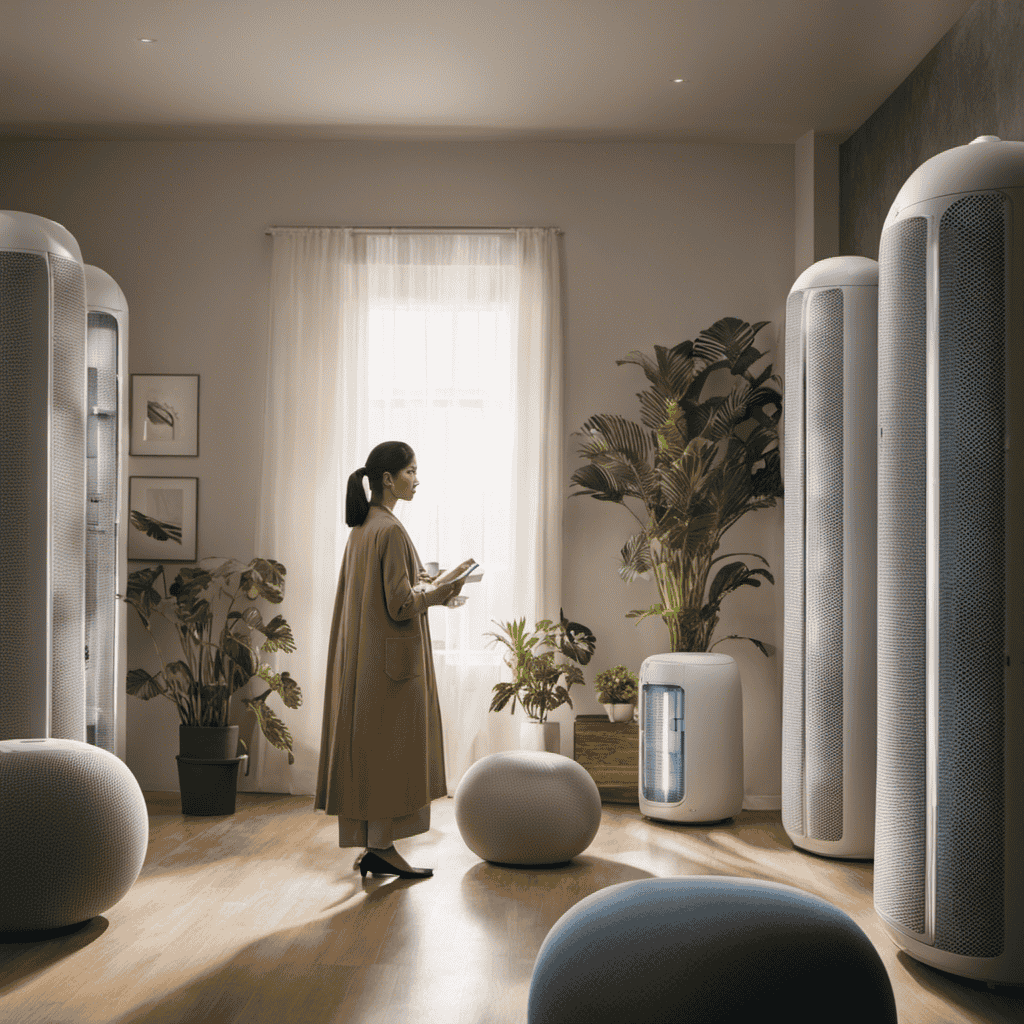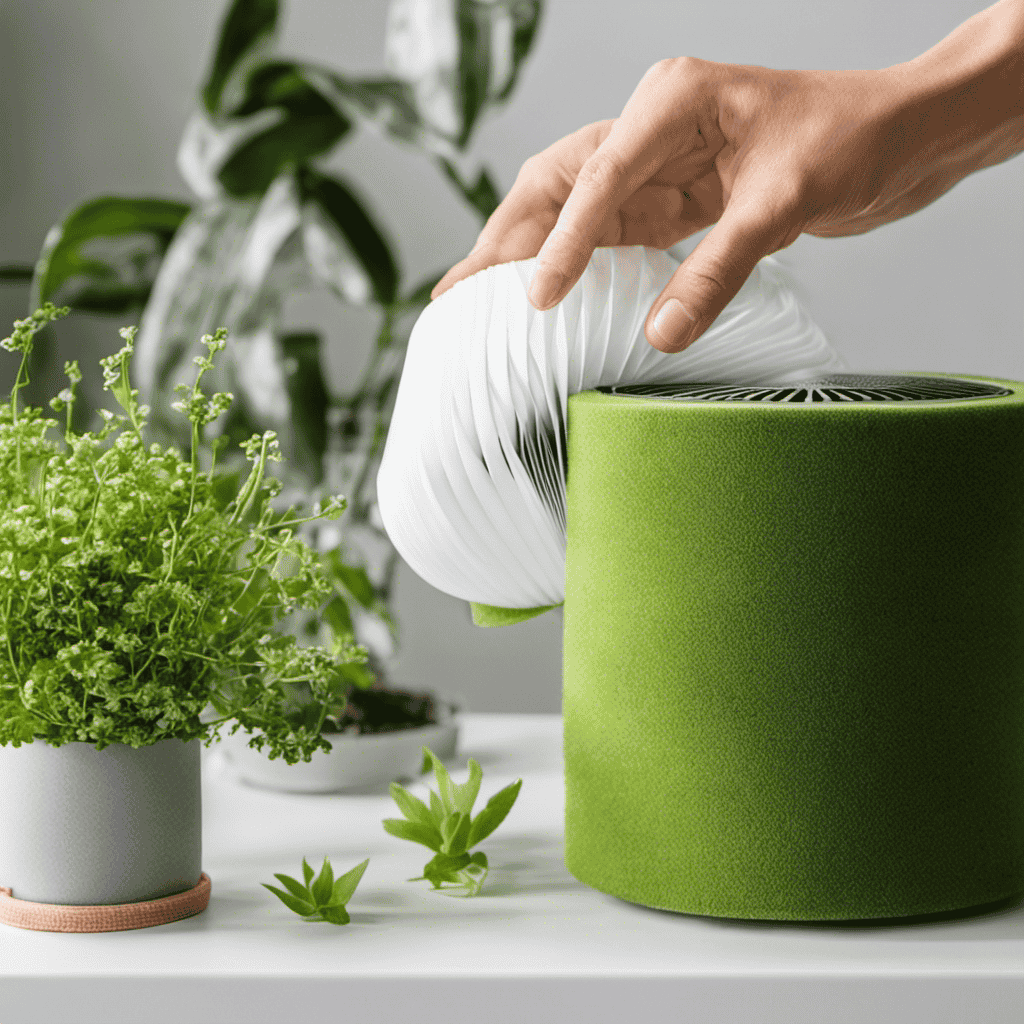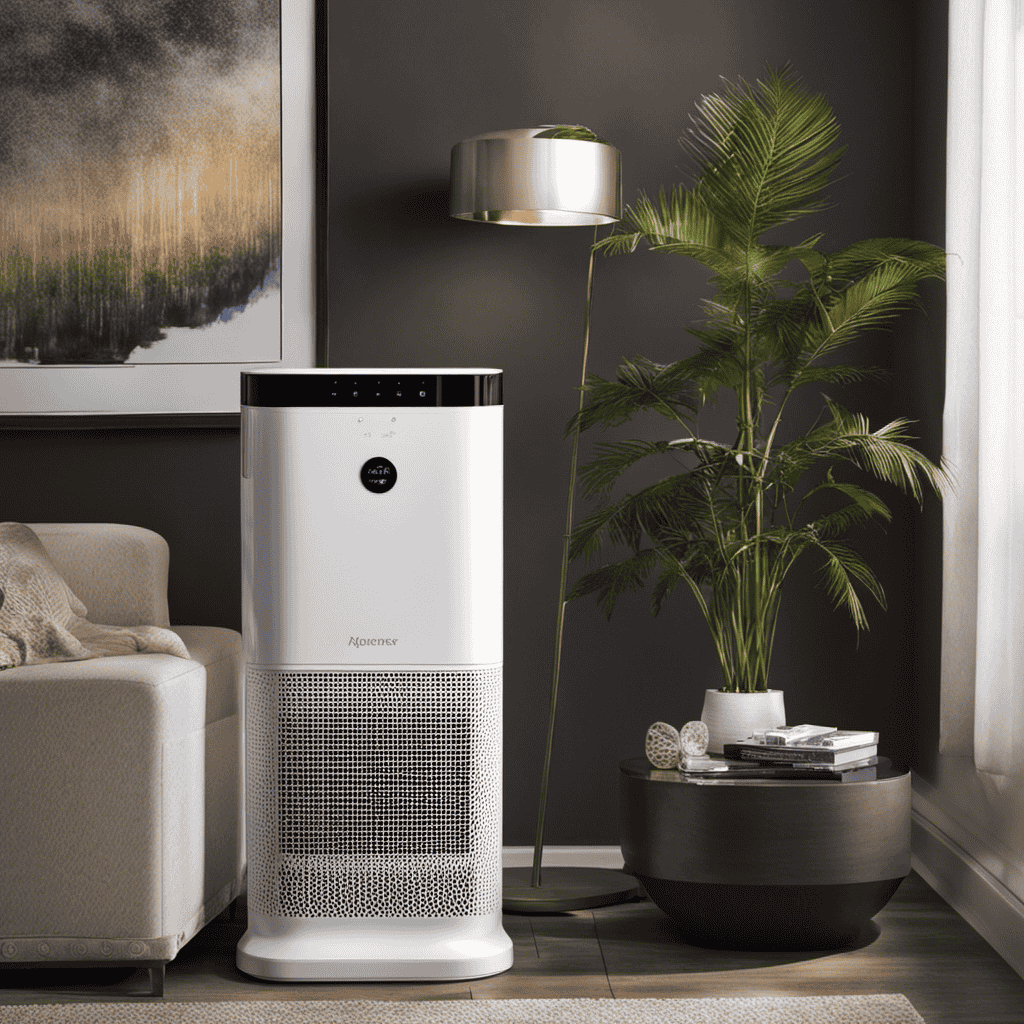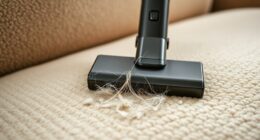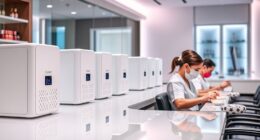I’ve embarked on a journey to discover the ideal air purifier, and believe me, it’s not as straightforward as one might think. The abundance of choices available makes it challenging to even know where to begin. However, worry no more! In this article, I’m going to divulge all the tips and tricks I’ve learned about choosing the perfect air purifier to meet your requirements.
From understanding the different types and filtration technology to considering room size and noise levels, I’ve got you covered.
So, let’s dive in and find the air purifier of your dreams!
Key Takeaways
- Choose an air purifier with a HEPA filter for effective removal of airborne particles.
- Ensure the air purifier is recommended for the size of the room to effectively remove pollutants.
- Look for air purifiers with accurate air quality sensors for proper monitoring and assessment.
- Consider the noise level and energy efficiency of the air purifier for a quiet and cost-effective operation.
Types of Air Purifiers
When selecting an air purifier, you should consider the different types available and how they can meet your specific needs.
One important factor to consider is the purifier effectiveness. Different types of air purifiers use different technologies to remove pollutants from the air. For example, HEPA filters are highly effective at removing airborne particles such as dust, pollen, and pet dander.
Another factor to consider is the filter lifespan. Some air purifiers require frequent filter replacements, while others have filters that can last for several months. It’s important to choose a purifier with a filter that is easy to replace and has a long lifespan.
By considering both purifier effectiveness and filter lifespan, you can select an air purifier that will effectively clean the air in your home.
Now, let’s move on to the next section about room size and coverage.
Room Size and Coverage
When it comes to air purifiers, understanding the optimal purifier room size and effective coverage area is crucial.
The size of the room and the purifier’s coverage area directly impact its performance and effectiveness in removing pollutants from the air.
Optimal Purifier Room Size
The purifier’s room size should be considered when selecting an air purifier. Optimal purifier room size is crucial for ensuring that the air purifier effectively cleans the air in the given space. When choosing an air purifier, it is important to match the purifier’s recommended room size with the actual size of the room.
This ensures that the purifier can efficiently purify the air and provide clean and fresh air for the occupants. When the room size is too large for the purifier’s capacity, it may not be able to effectively remove pollutants, allergens, and odors from the air. On the other hand, if the room size is smaller than the recommended capacity, the purifier may work too hard, leading to increased noise levels and reduced lifespan of the device.
Therefore, selecting the optimal purifier room size has several benefits, including better air quality, energy efficiency, and longer lifespan of the purifier.
Effective Coverage Area
To ensure the effective coverage area of your purifier, consider matching the recommended room size with the actual size of the space. This is important because if the purifier is too small for the room, it may not be able to effectively clean the air, while if it is too large, it may consume unnecessary energy.
When determining the effective coverage area, you should also take into account the room layout and air pollution levels. Here are four key points to consider:
-
Room layout: If your space has multiple rooms or an open floor plan, you may need multiple purifiers or a purifier with a higher coverage area to effectively clean the air in all areas.
-
Air pollution levels: If you live in an area with high air pollution levels or have specific indoor air quality concerns, it is advisable to choose a purifier with a larger coverage area to effectively remove pollutants.
-
Size and shape of the room: A room with a complex layout, corners, or multiple levels may require a purifier with a higher coverage area to ensure that all areas are adequately covered.
-
Ceiling height: If you have high ceilings, you may need a purifier with a higher coverage area to effectively clean the air in the entire vertical space.
Considering these factors will help you select an air purifier that can effectively clean the air in your space, ensuring a healthier indoor environment.
Filtration Technology
You should consider the HEPA filtration technology for better air purification.
When it comes to selecting an air purifier, understanding the different filtration technologies is crucial. HEPA, which stands for High-Efficiency Particulate Air, is highly effective in removing particles as small as 0.3 microns. This technology is recommended by experts for its ability to capture allergens, dust, pollen, pet dander, and even some bacteria and viruses.
To ensure optimal performance, regular maintenance is essential. This includes replacing the HEPA filters as recommended by the manufacturer, cleaning the pre-filters, and periodically checking and cleaning the sensors and vents.
When buying an air purifier, make sure to check if it uses HEPA filters, as this is a reliable and efficient filtration technology for clean and healthy indoor air.
Air Quality Sensors
When it comes to air quality sensors, one of the most important aspects is their accuracy. Having accurate sensors is crucial in order to properly assess and monitor the quality of the air we breathe.
There are different types of air sensors available, each designed to measure specific pollutants or particles in the air, such as carbon dioxide, volatile organic compounds, or particulate matter.
Understanding the importance of sensor accuracy and being aware of the different types of air sensors can help us make informed decisions when it comes to monitoring and improving the air quality in our environment.
Sensor Accuracy Importance
The accuracy of the sensor is crucial when choosing an air purifier. A well-calibrated sensor plays a significant role in the effectiveness of an air purifier. Here are four reasons why sensor accuracy is important:
-
Precise monitoring: A highly accurate sensor ensures that the air purifier can detect even minor changes in air quality, allowing it to adjust its purification settings accordingly.
-
Efficient operation: With accurate sensor readings, the air purifier can optimize its performance by running at the appropriate speed and targeting specific pollutants, resulting in efficient purification.
-
Timely alerts: A reliable sensor will promptly notify you when the air quality deteriorates, ensuring you can take necessary precautions or make adjustments to improve the indoor environment.
-
Longevity: By accurately measuring air quality, the sensor helps prevent unnecessary wear and tear on the purifier’s components, prolonging its lifespan.
Considering the impact of sensor accuracy on an air purifier’s effectiveness, it is essential to choose a model with a well-calibrated sensor.
Moving on to the next section, let’s explore the different types of air sensors available.
Types of Air Sensors
One way to determine the air quality in your environment is by using different types of air sensors. Air sensor technology has advanced significantly in recent years, allowing for more accurate and reliable air quality monitoring.
There are various types of air sensors available, each designed to measure specific pollutants or particles in the air. For example, particulate matter (PM) sensors can detect and measure the concentration of fine particles in the air, while volatile organic compound (VOC) sensors can identify and quantify harmful gases emitted from various sources. Other types of air sensors include carbon monoxide (CO) sensors, nitrogen dioxide (NO2) sensors, and ozone (O3) sensors.
By using these different types of air sensors, you can gain valuable insights into the air quality of your surroundings and take necessary actions to improve it.
Now, let’s move on to discussing the importance of noise level in our environment.
Noise Level
To find an air purifier with a low noise level, you should look for models that use advanced soundproofing technology. These models are designed to operate quietly, allowing you to enjoy clean air without any disturbances.
Here are four key features to consider when selecting an air purifier for quiet operation:
-
Noise level: Look for air purifiers that have a low decibel rating, typically below 50 dB. This ensures minimal noise during operation, especially in bedrooms or offices where silence is important.
-
Soundproofing technology: Some air purifiers incorporate specialized materials and design elements to reduce noise. Look for models that use sound-absorbing foam or vibration dampening technology to minimize sound transmission.
-
Fan speed settings: Opt for air purifiers with adjustable fan speed settings. Lower fan speeds often result in quieter operation, allowing you to customize the noise level based on your preferences.
-
Sleep mode: Consider air purifiers with a dedicated sleep mode. This feature typically reduces the fan speed and noise level during nighttime use, ensuring a peaceful and uninterrupted sleep.
Energy Efficiency
Consider looking for an energy-efficient model that will help you save on electricity costs while improving indoor air quality.
When selecting an air purifier, it’s important to consider its energy consumption and eco-friendly options. An energy-efficient air purifier is designed to minimize power usage while effectively removing pollutants from the air. Look for models that have an Energy Star certification, as these are tested and proven to consume less energy than standard models.
Additionally, consider air purifiers with features like automatic shut-off timers, sleep mode, and adjustable fan speeds, which allow you to customize the energy usage based on your needs. Eco-friendly options, such as filters made from recyclable materials or with longer lifespan, can also contribute to reducing waste and environmental impact.
Maintenance and Filter Replacement
When it comes to maintaining and replacing filters in an air purifier, there are a few key points to consider.
First, understanding the frequency of replacement is crucial to ensure optimal air quality.
Second, knowing the different types of filters available and their specific uses can help you choose the right one for your needs.
Lastly, learning about effective cleaning techniques will help prolong the lifespan of your filters and keep your air purifier running efficiently.
Frequency of Replacement
You should regularly check the filter of your air purifier for any signs of dirt or clogging. The frequency of filter replacement depends on various factors, such as the type of filter, the air quality in your area, and the usage of the air purifier. However, as a general guideline, most filters should be replaced every 6 to 12 months.
Here are a few key points to consider when it comes to the replacement frequency and filter lifespan:
-
Check the manufacturer’s recommendations: Some air purifiers come with specific instructions on when to replace the filter. It’s important to follow these guidelines for optimal performance.
-
Monitor air quality: If you live in an area with high pollution or have pets or smokers in your home, you may need to replace the filter more frequently.
-
Regular maintenance: Cleaning and maintaining the filter regularly can help prolong its lifespan. Vacuuming or rinsing the filter can remove dirt and debris and extend its effectiveness.
-
Filter indicators: Some air purifiers have built-in filter indicators that alert you when it’s time to replace the filter. Pay attention to these indicators to ensure your air purifier is working efficiently.
Types of Filters
The different types of filters for air purifiers can vary in their effectiveness and suitability for specific air quality issues. When it comes to air purifier maintenance, understanding the types of filters available is crucial.
There are three main types of filters commonly used in air purifiers: HEPA filters, activated carbon filters, and pre-filters. HEPA filters are highly efficient in removing small particles, such as dust, pollen, and pet dander, from the air. Activated carbon filters are excellent at removing odors and harmful chemicals from the air. Pre-filters, on the other hand, capture larger particles like hair and lint, extending the lifespan of the main filter.
Cleaning Techniques
Regularly cleaning and replacing filters is essential for maintaining optimal performance and prolonging the lifespan of your air purifier. Here are four cleaning techniques and filter maintenance tips to ensure your air purifier functions effectively:
-
Vacuuming: Use a soft brush attachment to remove dust and debris from the surface of the filter. This will help maintain proper airflow and prevent clogs.
-
Washing: Some filters are washable. Follow the manufacturer’s instructions to clean them thoroughly. Allow the filters to dry completely before reinstalling.
-
Replacement: Filters have a limited lifespan. Check the user manual for recommended replacement intervals and ensure you have replacement filters on hand.
-
Pre-filters: Many air purifiers have pre-filters that capture larger particles. Clean or replace these pre-filters regularly to prevent them from becoming clogged.
By following these cleaning techniques and filter maintenance tips, you can ensure your air purifier continues to provide clean and fresh air.
Now let’s explore some additional features to consider when selecting an air purifier.
Additional Features
When selecting an air purifier, it’s important to consider additional features such as a remote control or a timer. These features can greatly enhance the convenience and functionality of your air purifier.
In terms of design, look for a sleek and compact unit that will blend seamlessly into your home decor.
Many air purifiers now offer smart home integration, allowing you to control the device through your smartphone or other smart devices. This feature enables you to monitor and adjust the settings of your air purifier from anywhere, giving you complete control over your indoor air quality.
Additionally, some air purifiers come with built-in sensors that can automatically adjust the fan speed and filtration levels based on the air quality in your home. These advanced features make it easier than ever to maintain clean and healthy air in your living space.
Budget Considerations
Consider your budget and prioritize the features that are most important to you when choosing an air purifier. It’s essential to find a purifier that fits within your price range while still providing the necessary filtration capabilities. To help you make a cost-effective choice, here are four key factors to consider:
-
Filter Replacement Cost: Look for air purifiers with affordable filter replacements. Some models have filters that need to be replaced more frequently, which can add up in the long run.
-
Energy Efficiency: Opt for energy-efficient air purifiers that consume less electricity. This not only helps reduce your carbon footprint but also saves you money on energy bills.
-
Coverage Area: Determine the size of the room or space you want to purify. Choosing a purifier with the right coverage area ensures optimal performance without overspending.
-
Maintenance and Warranty: Consider the maintenance requirements and warranty offered by the manufacturer. A longer warranty period can provide peace of mind and potential cost savings if any issues arise.
Brand Reputation and Customer Reviews
Finding a budget-friendly air purifier that meets your needs can be easier when you take into account brand reputation and customer reviews. Brand loyalty plays a significant role in determining the quality of an air purifier. Well-established brands often have a track record of producing reliable and efficient products. These brands invest in research and development to continually improve their air purifiers’ performance.
Customer reviews are also invaluable in making an informed decision. Online ratings and reviews provide insights into the experiences of other users. They can help you gauge the effectiveness, durability, and overall satisfaction of a particular air purifier model.
Warranty and After-Sales Support
To ensure peace of mind, it’s important to look into the warranty and after-sales support offered by different brands. When purchasing an air purifier, it’s crucial to consider the level of customer satisfaction and the brand’s return policy. Here are four key factors to consider:
-
Warranty duration: Check how long the warranty covers the air purifier. A longer warranty period indicates the brand’s confidence in their product’s quality.
-
Parts and labor coverage: Ensure that both parts and labor are included in the warranty. This will protect you from unexpected repair costs.
-
Support availability: Find out if the brand offers reliable after-sales support. This includes assistance with troubleshooting, replacement parts, and repairs.
-
Return policy: Familiarize yourself with the brand’s return policy. In case you are not satisfied with the air purifier, it’s essential to know if you can return it and receive a refund or exchange.
Considering these factors will help you make an informed decision, ensuring your satisfaction and peace of mind with your air purifier purchase.
Frequently Asked Questions
What Are the Potential Health Benefits of Using an Air Purifier?
Using an air purifier has potential health benefits such as reducing indoor air pollution, allergens, and odors. However, it’s important to be aware of potential drawbacks and side effects, so proper research and consideration are necessary.
Can an Air Purifier Eliminate All Types of Indoor Air Pollutants?
No, an air purifier cannot eliminate all types of indoor air pollutants. While it can be effective in removing common pollutants like dust, pollen, and pet dander, it may not be as effective against gases, chemicals, and viruses.
Are Air Purifiers Safe to Use Around Children and Pets?
Air purifiers are like invisible shields, protecting my family from harmful pollutants. When selecting one, I prioritize safety precautions, ensuring it’s safe around children and pets. I also compare their effectiveness to make the best choice.
How Long Does It Typically Take for an Air Purifier to Improve Indoor Air Quality?
It typically takes an air purifier a few hours to start improving indoor air quality. The effects on allergies and impact on respiratory health can vary depending on the size of the room and the purifier’s efficiency.
Are There Any Potential Drawbacks or Side Effects of Using an Air Purifier?
There are potential risks and possible side effects of using an air purifier. It’s important to be aware of these before making a selection. (35 words)
Conclusion
In conclusion, selecting the right air purifier is crucial for improving indoor air quality and promoting a healthier living environment. By considering factors such as room size, filtration technology, air quality sensors, noise level, and additional features, you can make an informed decision.
It’s also important to take into account your budget, brand reputation, customer reviews, and warranty options. So, why wait any longer? Take the necessary steps to breathe cleaner air and enjoy a fresh and revitalizing atmosphere in your home.
